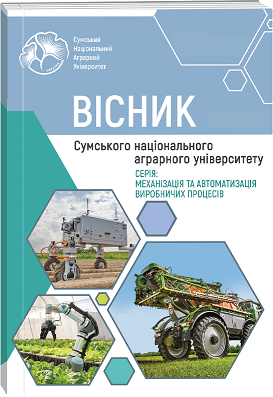JUSTIFICATION OF CENTRIFUGAL RADIAL FAN CONFIGURATION CHOICE USING SOLIDWORKS AND ANSYS CFX SOFTWARE COMPLEXES
Abstract
With the development of computer and software systems, Computational Fluid Dynamics modeling (CFD modeling) has been eliminated, which is based on the development of systems to save mass, energy and resources, which describe the flow of technology ій in shoveling machines. All this makes it possible to save time and material resources in comparison with experimental research, as well as to carry out an optimal interpretation of the physical, geometric parameters and the borderline minds of the researched object. Ekta. This article examines the possibility of using the ANSYS 19.0 CFX software package for trivial numerical modeling of gas-dynamic processes, such as those required by the Center Radial Fan (VRV). The aerodynamic characteristics of the air blower were analyzed on the basis of the design, analysis of which made it possible to eliminate phenomena about the processes that occur in the flow part of the fan for different design configurations: No. 1, No. 2 and No. 3 for different values. spend again G_m. The ANSYS 19.0 CFX software package makes it possible to read the numerical values of parameters, as well as visualize the behavior of parameters in the flow part of the fan. The ANSYS program allows you to select a VRV of a specific configuration and change the size of the wind flow when specifying the size of the wind flow models: the ideal knitting is normal (in the frame of the model middle), laminar or turbulent flow to the wind, the rarefied and compressed middle, the two-worldly and the three-worldly. This article examines the work of the VRV during the process of passing an ideal, non-crampy model medium through its flow part into a trivial medium. A turbulence model for trivimiral flow, Menter’s Shear Stress Transport (SST model), which is a hybrid model between k-ε and k-ω turbulence models, has been adopted. Thus, the SST model has the same stability and accuracy as the standard k-ω model in the near-wall areas and the k-ε model at the wall-mounted area. It was possible to obtain a picture of the sub-vice of the flow part, the fields of fluid vectors and the direction of the wind flow for conditioning and analysis of the results.
References
2. Anderson, J. D. Jr. (1995). Computational Fluid Dynamics: The Basics with Applications. New York: McGraw-Hill, 546 p.
3. Babu, V. (2021). Fundamentals of gas dynamics (2nd ed). Berlin: Springer, 195 p.
4. Batchelor G.K. (2000) An Introduction to Fluid Dynamics. Cambridge: Cambridge University Press, 615 p.
5. Chung, T. J. (2002). Computational fluid dynamics. [Computational fluid dynamics.], Cambridge: Cambridge University Press, 1029 p.
6. Drankovskyi V. E., Myronov K. A., Tynianova I. I. ta inshi (2022) Matematychne modeliuvannia robochoho protsesu hidromashyn : navch. posib. [Mathematical modeling of the working process of hydraulic machines: a textbook]. Kharkiv: NTU «KhPI», 406 p. (in Ukrainian).
7. Fletcher, A. J. (1988). Computational techniques for Fluid Dynamics. New York: Springer-Verlag: Berlin, 479 p.
8. Frank, M. (2016). White fluid mechanics (8th ed.). New York: McGraw-Hill Education, 849 p.
9. Hirsch, C. (2007) Numerical computation of internal and external flows (2nd ed.). Oxford: Published by John Wiley & Sons, Ltd, 695 p.
10. Ing. Dr. techn. Back O. (1955). Ventilatoren entwurf und berechnung. [Fans design and calculation] Halle (Saale), 362 p. (in German).
11. Jeffreys G., Swirles B. (1999). Methods of mathematical physics. By SIR HAROLD JEFFREYS M. A., D Sc., F.R.S. and BERTHA SWIRLES (LADY JEFFREYS) M.A., Ph.D. 3rd edition Cambridge: Cambridge University Press, 728 p.
12. Mironov K. A., Oleksenko Yu. Yu. (2019) Doslidzhennia potoku ridyny v dvovymirnii i tryvymirnii postanovtsi v protochnii chastyni vysokonapirnoi radialno-osovoi hidroturbiny. [Research of fluid flow in two-dimensional and three-dimensional formulation in the flow part of a high-pressure francis turbine]. Kharkiv: Bulletin of the National Technical University "KhPI". Hydraulic machines and hydraulic units, No 1’2019, pp. 72–76.
13. Mironov K. A., Oleksenko Yu. Yu., Mironov V. K. (2018) Doslidzhennia prostorovoi techii v protochnii chastyni vysokonapirnoi radialno-osovoi hidroturbiny. [Study of the spatial flow in the flow part of the high-pressure francis turbine] Kharkiv: Bulletin of the National Technical University "KhPI". Hydraulic machines and hydraulic units, 46’2018, pp. 25–29.
14. Regina P. Bracy, Richard L. Parish, and Joe E. McCoy. (1999) Precision Seeder Uniformity Varies with Theoretical Spacing. Alexandria: HortTechnology, 9 (1)’ pp. 47–50.

 ISSN
ISSN  ISSN
ISSN 



